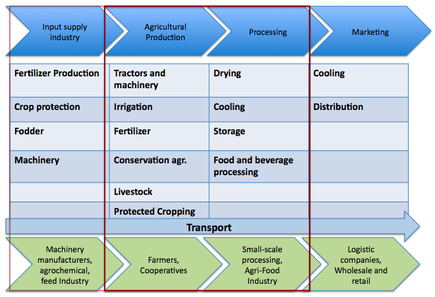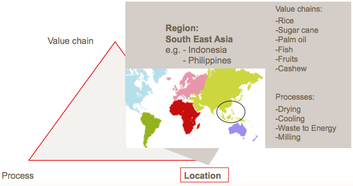Energy Efficiency in Powering Agriculture
Overview
The global potential for energy savings is enormous, reaching up to 50% in developing countries and transition economies. This page shall serve as an overview page of articles relating to energy efficiency within the agriculture and food sector.
Basics of Energy Efficiency
Energy conversions always imply energy losses. Converting energy from one into another is necessary for utilising energy. For instance, in lift irrigation: A diesel engine converts chemical energy of oil into mechanical energy for powering the shaft of a pump. This pump then converts shaft power into potential energy of water by bringing the water to a higher height. Energy conversion is also necessary for energy generation: A solar PV cell generates energy by converting radiation energy into electricity. Within the conversion a share of energy is lost. This leads to the concept of energy efficiency.[1]
The efficiency of an energy converter (e.g. solar cell, turbine, motor) is defined as the quantity of energy in the desired form (the output energy) divided by the quantity of energy put in for conversion (the input energy).[2]
For more details - check out the introduction on energy efficiency.
Energy Efficiency
Energy efficiency is an integral part of sustainable energy management in order to reduce energy consumption and decouple it from economic growth.
Energy efficiency can lead to ecological and economic win-win situations. Lower costs for industry increase both competitiveness and job security. Also private households benefit, an impact that particularly benefits the poorer segments of a community, who frequently spend a disproportionately large portion of their income on energy. Further, everyone benefits from the positive effects on the climate and environment that result from lower greenhouse gas emissions and the reduced consumption of natural resources (GIZ, Energy Efficiency).
Energy efficiency measures must target areas where energy is actually “consumed”: energy production, transmission and distribution, buildings, industry, private households, municipal facilities, and the transport sector. One key sector is the agriculture and food sector, which consumes about 30% of the global energy[3]. Thus, improving energy efficiency in agriculture is essential to reduce energy demand and hence reduce costs. Further, improved energy efficiency reduces reliance on fossil fuels and therefore contributes to reducing GHG emissions.
Energy Efficiency of Agricultural Processes
The processes along the value chain, as shown in the graph to the right, are heavily dependent on the use of fossil fuels. In agricultural production for example, this includes indirect energy inputs in the form of energy-intensive manufactured fertilizers and pesticides, as well as direct inputs such as diesel for tractors and tillage or energy for operating irrigation systems.
Energy demand can be reduced in all agricultural processes where energy is used, by appropriate technology changes, as well as by improved management and operations. Broadly seperated one can look at agricultural production and processing.
►Go to Top
Agricultural Production
Indirect inputs such as fertilizer or pesticides present significant energy saving potential at the level of agricultural production. Here, the so-called Conservation Agriculture offers effective approaches: This concept refers to measures helping to maintain and improve soil quality. Thus, crop rotations, e.g. by planting legumes and the associated availability of nutrients, as well as ploughless soil cultivation can improve soil fertility. On the one hand this leads to a decreasing demand for energy-intensive manufactured fertilizers, and on the other hand reduces direct energy inputs, e.g. due to the reduced diesel consumption.
Irrigation systems present one of many examples. Irrigated agriculture is a crucial part of global agriculture, increasing productivity significantly. However, it is under pressure to adopt best practices to improve efficiency in terms of water use and energy costs.
Further areas for energy saving potentials within agriculture and energy are the diesel efficiency in agriculture and transport. The largest demand in the field of agricultural production refers to optimized irrigation technologies, such as solar pumps. Thereby, the focus is particularly on the fruit and vegetable sector.
Food Processing Industry
A larger demand for measures in the fields of energy efficiency and renewable energies was registered from agricultural production than from the food processing industry. Cooling and heating constitute examples. For instance, greenhouse heating can be essential for the year-round production of fruit, vegetables or flowers. Temperature controlled storage and refrigeration systems are also crucial for example in the horticulture and vegetable industry, but consume considerable amounts of electricity. According to Bundschuh and Chen (2014[4]) improvements to technical elements and operation of modern refrigeration systems have the potential to reduce energy consumption by 15-40%.
Identification of Energy Saving Potentials
Based on this demand three possible approaches can be identified: a regional focus, a focus on value chains as well as a process-oriented focus.
Regional Approach
The largest potentials are to be located primarily in Asia and Africa, but also in Latin America. Using the example of the hotspot of Southeast Asia it becomes clear that there is a diverse range of possible regional contact points for future studies and activities in the field of renewable energies and energy efficiency.
Value Chain Approach
Especially, the following value chains offer optimization potentials: rice, tea, vegetables /fruits, cocoa, coffee, palm oil, cashew, forestry, fish. The example of the fruits and vegetable value chains shows evidently that in addition to the above listed irrigation, also cooling, processing and energetic use of waste materials offer energy saving potentials.
Process-oriented Approach
In terms of value chain processes, potential for optimized energy use are particularly to be found in irrigation, drying, cooling, storage, and packaging mills. The example of drying shows that a deeper analysis on this topic can connect numerous value chains and target countries.
Project Examples
- Efficient Stoves for Producing Shea Butter
- Smart Energy Concept Chile
- Energy Efficiency Potentials in the Kenyan Tea Sector
Further Information
- Water and Energy for Food (WE4F) portal on energypedia
- Energy for Agriculture
- All "Energy Efficiency" related articles on energypedia
References
- ↑ GIZ, Energy Efficiency. http://www.giz.de/expertise/html/13356.html
- ↑ FAO, 1991. Energy for sustainable rural development Projects.
- ↑ FAO, 2011: “Energy-smart” food for people and climate – Issue Paper: http://www.fao.org/docrep/014/i2454e/i2454e00.pdf
- ↑ Jochen Bundschuh & Guangnan Chen, 2014. Sustainable Energy Solutions in Agriculture.























